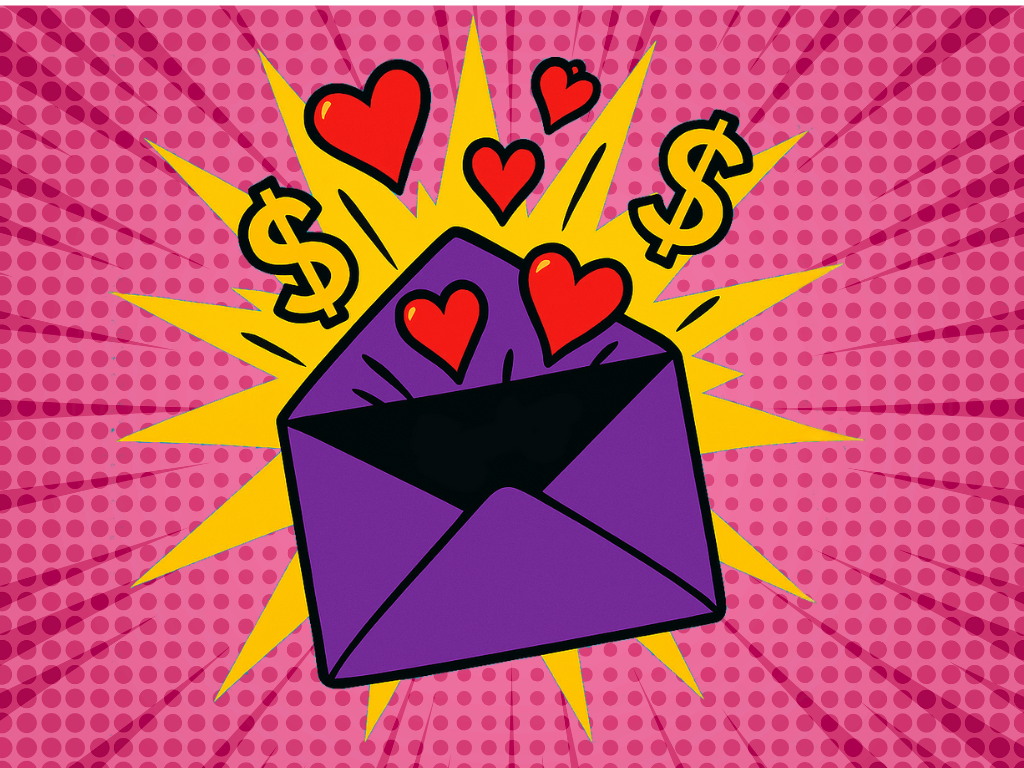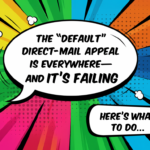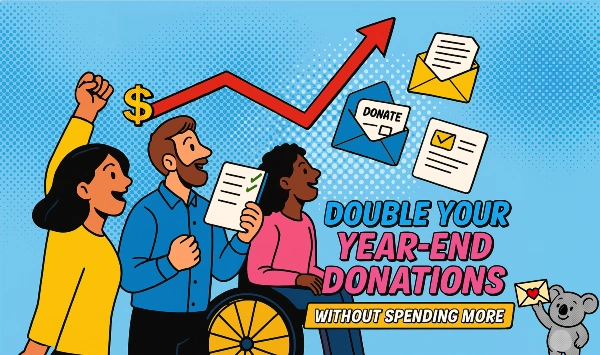There’s a reason I’ve spent more than 25 years peering into donor mailboxes. The truth is: most of what shows up in there is easy to ignore. Perfectly branded. Polished. Bland.
It’s mail that’s trying to be liked by the boss or the board rather than loved by donors. And that’s a problem.
Because the best, most compelling and money-raising fundraising isn’t a transaction. It’s a conversational, emotive, and vulnerable relationship.
Design — real, thoughtful, donor-focused design — plays a crucial role in building that relationship. So here are ten things that will help your next appeal raise more money, all rooted in direct response fundamentals, decision science, and a little thing we like to call donor love.
Tip #1: Start with the Envelope
Your envelope has one job – which is to “dominate” your donor’s mailbox the day it lands there. And you have about three seconds to do that. Maybe.
Your donor is standing at the mailbox with a stack of bills, flyers, and other junk. Your envelope has to earn its way into their hands — and their heart.
Skip the white #10 with a logo. Instead, try:
- A different size or colour
- A teaser that intrigues (“One song. A thousand memories.”)
- A hand-addressed look or an element of surprise
If it looks like a real human made it — and not a machine — you’ve already won the first battle.
Tip #2: Stop Worshipping Your Logo
Your logo doesn’t inspire gifts. It never has.
In fact, I’ve seen tests where putting the logo on the outer envelope decreased response rates. Why? Because it signals “junk mail.”
Your brand should live in how the donor feels — not in your brand PMS colour or that special font someone paid a consultant $100K to create. Effective fundraising design starts with this question: “How does or how will this make my donor feel?”
Tip #3: Use Courier. Seriously.
If you’re not designing using 14-point type and choosing fonts like Courier or Prestige, you’re missing out on the power of nostalgia and clarity. Courier isn’t just a typeface — it’s a time machine. It transports the reader to a different era – when people sent letters typed on typewriters. And guess what? That emotional lift helps response.
(If you guessed my favourite font is Courier, you get full marks and a smiley face :))
Tip #4: Get to the Point. Ask for One Thing.
Decision science tells us that too many choices = paralysis. Want more response? Ask for one thing.
Don’t tell donors everything about your mission. Tell them about one thing they can help fix, right now, and why it matters.
One problem. One solution. One clear ask.
Tip #5: Tell Real Stories That Invite the Donor In
Not brand stories. Not success stories.
Donor stories.
Stories where the donor can play a heroic role, where their values are reflected back to them, where their help is urgently needed.
Tip #6: Design for Grandma
When I review appeal packs, I ask: “Would your grandmother understand this? Would she feel seen, respected, appreciated?”
If your fonts are too small, your sentences too long, your paragraphs too dense — your message is being lost. Don’t design for your boss. Design for someone you love.
Can I give a shout out to white space? Great, donor respecting designers love it because it separates and emphasizes other design elements – you know – like the amazing words your copywriter slaved over.
Tip #7: Use Involvement Devices and Delightful Extras
A paperclip. A coffee ring. A scribbled note. A photo tucked inside.
These are the things that make a donor feel like they’re opening a personal letter, not marketing. Decision science tells us that perceived effort matters — the more effort something feels like it took, the more valuable it seems.
Take the time. Add the weird. It works.
Tip #8: Let Donors Talk Back
If giving is a conversation, then you need to stop shouting.
In one appeal for St. Patrick’s Home, we included a space on the reply form for donors to share a memory tied to music. The responses were heartbreaking and beautiful. One donor walked in with her torn envelope in hand and a cheque for $20,000.
When you let donors speak, they reveal who they are. And when you really listen, they give more.
Tip #9: Forget Pretty. Focus on Effective.
Design isn’t about how something looks. It’s about how it works.
Courier, high-contrast type, cheesy photos, oversized reply forms… they’re not pretty, but they get results. And isn’t that the point?
Tip #10: Obsess Over a Thousand Small Things
Direct response fundraising is a craft. An art. A discipline.
You cannot automate it. You cannot “brand” your way to success. You have to care. About the tone of your ask. The weight of your paper. The crop on your photo. The way the ink smudges just slightly when you underline a sentence with emotion.
Donors notice more than we think. And they respond when it feels like love.
You don’t need a revolution. You need a thousand tiny creative deviations that show your donor they matter.
That’s what design in direct response is really about — creating an experience where the donor feels like they’re the most important person in the world.
Because to your cause, they are.
So go ahead: ditch the brand book, pick up your pencil, and design something your donor will feel. Something that moves her to tears. Something she will open, read, and respond to.
I’ll be cheering you on. And probably designing your next envelope in my head while making some dough for my homemade, buttermilk buns.
John Lepp is author of the book Creative Deviations and Partner/Creative Director at Agents of Good agentsofgood.org in Canada. His Moceanic workshop, Graphic Design for Fundraising, is available to members of The Fundraisingology Lab. Join the waitlist here.
Fundraising is a challenging career – but one of the best lives you can choose. To help you advance your career in a proven, logical, experience-based way, we’ve created a new Starter Guide for Your Fundraising Success Path. Download it now and you’ll start your journey to mastery and success in the best career on Earth!
Please share your experience by leaving your reply below. We’d love to learn from your experience.











